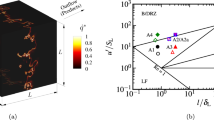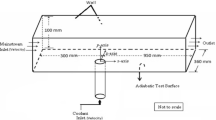Abstract
The direct numerical simulation (DNS) method with 16 steps detailed chemical kinetics was applied to a lifted turbulent jet flame with H2/N2 fuel issuing into a wide hot coflow of lean combustion products, at temperature of 1045 K and low oxygen concentrations. The chemical reactions were handled by the library function of CHEMKIN which was called by the main program in every time step. Parallel computational technology based on message passing interface method (MPI) was used in the simulation. All the cases were run by 12 CPUs on a high performance computer system. Faver-averaged DNS results were obtained by long time averaging the transient profile and compared with the experimental data. The roll-up and evolution of the vortices in jet flame were well captured. The vortices in the same rotating direction attracted each other and those in different rotating directions repulsed each other. Through complex interactions between vortices, the original symmetrical vortex structure could be converted into nonsymmetrical and more complex structures by combination, distortion and splitting of the vortices. The transient profiles of H, OH and H2O mass fraction at 5.76 ms showed the flame structure in jet flame, especially the autoignition regions clearly. The lift-off height was about 9 d–11 d, in agreement with the experimental observation. At the corner point of the flame sheet indicated by OH and H profiles, the combustion was always enhanced by the flame curvature and extended resident time. The profiles of turbulence intensities show that the flames were diffused from the original two outside flame sheets into the core. The DNS results can be considered in developing more accurate and more universal turbulence models.
Similar content being viewed by others
References
Burgess C P, Lawn C J. The premixture model of turbulent burning to describe lifted jet flames. Combust Flame, 1999, 119: 95–108
Wu C Y, Chao Y C, Cheng T S, et al. The blowout mechanism of turbulent jet diffusion flames. Combust Flame, 2006, 145: 481–494
Kim I S, Mastorakos E. Simulations of turbulent Non-premixed counterflow flames with first-order conditional moment closure. Flow Turbul Combust, 2006, 76: 122–162
Barlow R S, Smith N S A, Chen J Y, et al. Nitric oxide formation in dilute hydrogen jet flames: Isolation of the effects of radiation and turbulence-chemistry submodels. Combust Flame, 1999, 117: 4–31
Wang H, Chen Y. Flamelet modeling of turbulent non-premixed flame based on detailed chemical reaction mechanisms. J Combust Sci Technol, 2004, 10: 77–81
Christo F C, Dally B B. Modeling turbulent reacting jets issuing into a hot and diluted coflow. Combust Flame, 2005, 142: 117–129
Cabra R, Chen J Y, Dibble R W, et al. Lifted methane-air jet flames in a vitiated coflow. Combust Flame, 2005, 143: 491–506
Wang H, Yiliang C. A PDF simulation of the lifted turbulent H2/N2 jet flame. Chin J Comput Phys, 2006, 23: 73–79
Yong J, Rong Q, Wei Z, et al. Conditional moment closure modeling of a lifted turbulent flame. Chin Sci Bull, 2005, 50: 1261–1269
Cao R R, Pope S B, Masri A R. Turbulent lifted flames in a vitiated coflow investigated using joint PDF calculations. Combust Flame, 2005, 142: 438–453
Chen J H, Hawkes E R, Sankaran R, et al. Direct numerical simulation of igintion front propagation in a constant volume with temperature inhomogeneities I. Fundamental analysis and diagnostics. Combust Flame, 2006, 145: 128–144
Mahalingam S, Chen J H, Vervisch L. Finite-rate chemistry and transient effects in direct numerical simulations of turbulent nonpremixed flames. Combust Flame, 1995, 102: 285–297
Hawkes E R, Chen J H. Direct numerical simulation of hydrogen-enriched lean premixed methane-air flames. Combust Flame, 2004, 138: 242–258
Echekki T, Chen J H. Direct numerical simulation of autoigintion in non-homogeneous hydrogen-air mixures. Combust Flame, 2003, 134: 169–191
Im H G, Chen J H. Preferential diffusion effects on the burning rate of interacting turbulent premixed hydrogen-air flames. Combust Flame, 2002, 131: 246–258
Hilbert R, Thevenin D. Autoignition of turbulent non-premixed flames investigated using direct numerical simulations. Combust Flame, 2002, 128: 22–37
Viggiano A, Magi V. A 2-D investigation of n-heptane autoignition by means of direct numerical simulation. Combust Flame, 2004, 137: 432–443
James S, Jaberi F A. Large scale simulation of two-dimensional nonpremixed methane jet flames. Combust Flame, 2000, 123: 465–487
Jiang X, Luo K H. Direct numerical simulation of the near field dynamics of a rectangular reactive plume. Int J Heat Fluid Flow, 2001, 22: 633–642
Jiang X, Luo K H. Dynamics and structure of transitional buoyant jet diffusion flames with side-wall effects. Combust Flame, 2003, 133: 29–45
Cabra R. Turbulent jet flames into a vitiated coflow. Dissertation for the Doctoral Degree. Berkeley: University of California, 2003
Cabra R, Chen J Y, Dibble R W, et al. Simultaneous Laser Raman-Rayleigh-LIF measurements and numerical modeling results of a lifted turbulent H2/N2 jet flame in a vitiated coflow. 29th International Symposium on Combustion. Sapporo: Combustion Institute, 2002
James S F A J. Large scale simulation of two-dimensional nonpremixed methane jet flames. Combust Flame, 2000, 123: 465–487
Kee R J, Rupley F M, Miller J A, et al. CHEMKIN User’s Guide Version 4.0, 2004
Zhou X, Sun Z, Brenner G, et al. Combustion modeling of turbulent jet diffusion H2/air fame with detailed chemistry. Int J Heat Mass Transf, 2000, 43: 2075–2088
Fan J, Luo K, Ha M Y, et al. Direct numerical simulation of a near-field particle-laden plane turbulent jet. Phys Rev E, 2004, 70: 026303.
Stanley S, Sarkar S, Mellado J. A study of the flow field evolution and mixing in a planar turbulent jet using direct numerical simulation. J Fluid Mech, 2002, 450: 377–407
Eswaran V, Pope S B. An examination of forcing in direct numerical simulations of turbulence. Comput Fluids, 1988, 16: 257–278
Jimenez J, Wray A A, Saffman P G, et al. The structure of intense vorticity in isotropic turbulence. J Fluid Mech, 1993, 255: 65–90
Grimmett T K. A DNS study of differential diffusion in nonpremixed reacting turbulent flows using a generalized Burke-Schumann formulation. Dissertation for the Doctoral Degree. San Diego: University of California, 2001
Kops S M D B. Numerical simulation of non-premixed turbulent combustion. Dissertation for the Doctoral Degree. Washington: University of Washington, 1999
Poinsot T J, Lele S K. Boundary conditions for direct simulation of compressible viscous flows. J Comput Phys, 1992, 101: 104–129
Baum M, Poinsot T, Thevenint D. Accurate boundary conditions for multicomponent reactive flows. J Comput Phys, 1994, 116: 247–261
Stanley S A. A computational study of spatially evolving turbulent plane jets. Dissertation for the Doctoral Degree. San Diego: University of California, 1998
Wang Z, Zhou J, Fan J, et al. Direct numerical simulation of ozone injection technology for NOx control in flue gas. Energy Fuels, 2006, 20: 2432–2438
Author information
Authors and Affiliations
Corresponding author
Additional information
Supported by China Postdoctoral Science Foundation (20060391042), the Key Project of Chinese National Programs for Fundamental Research and Development (2006CB 200303), the National Natural Science Foundation for Distinguished Young Scholars (Grant No. 50525620), and Natural Science Foundation of Zhejiang Province (Grant No. Z104314)
About this article
Cite this article
Wang, Z., Fan, J., Zhou, J. et al. Direct numerical simulation of hydrogen turbulent lifted jet flame in a vitiated coflow. CHINESE SCI BULL 52, 2147–2156 (2007). https://doi.org/10.1007/s11434-007-0290-1
Received:
Accepted:
Issue Date:
DOI: https://doi.org/10.1007/s11434-007-0290-1




